If you’re wondering how to tell time in Spanish, you’ve come to the right place. In this guide, you’ll find everything you need to know to be able to tell time in Spanish at a native speaker’s level.
The topics you’ll learn are:
- Different ways to tell the time in Spanish
- Elements to Tell Time in Spanish
- Telling the Time in the Past & Future
- 24-Hour Time Format
- Asking the Time in Spanish
- Vocabulary for Telling Time Vocabulary
- Key Points: Rules for Telling Time in Spanish
Different Ways to Tell Time in Spanish
Below, you’ll find different ways to tell time in Spanish. All of these options express the same time (1:45).
- Es la una y cuarenta y cinco
- Es la una con cuarenta y cinco minutos
- Es la una cuarenta y cinco
- Son las dos menos quince
- Faltan quince a las dos
- Son quince a/para las dos
- Es cuarto para las dos
You’ll learn all 7 of these ways and the nuances in the following sections.
Get the Telling Time in Spanish Cheat Sheet
Join the TMIS community and get my Spanish Learner’s Roadmap, my tricky Spanish synonyms cheat sheets and a pin-up cheat sheet for Telling Time in Spanish.
Formula for Telling Time in Spanish
To tell time in Spanish, you must use the following elements:
- Verb ‘ser’ conjugated in the 3rd person:
- plural (‘son’) for hours from 2 to 12
- the 3rd person singular (‘es’) for 1:00 am/pm.
- Spanish definite articles
- Las for hours from 2 to 12
- La only for 1:00 am/pm.
- Numbers to indicate the hours and minutes.
- The word ‘y’ to add minutes (optional).
- Phrases to express the part of the day (optional).
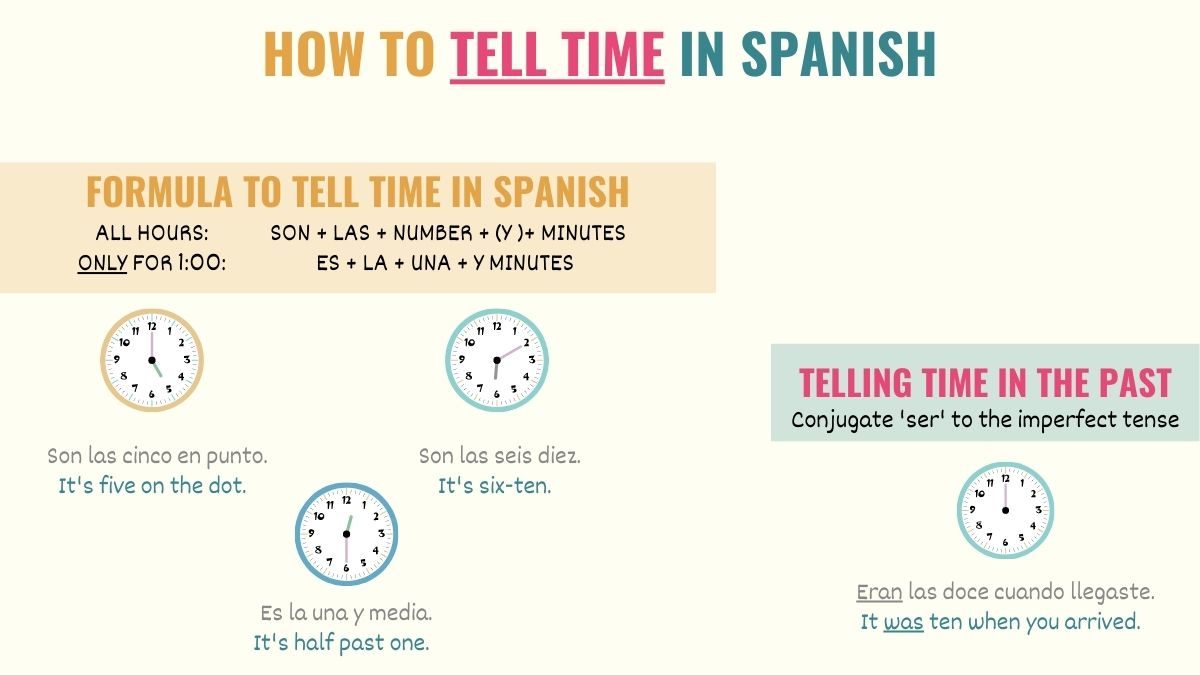
As mentioned above, there’s a singular and a plural formula to tell time in Spanish. The plural structure is used with all the hours except for 1:00 am/pm.
So, a simple formula to tell time in Spanish looks like this:
For 1:00-1:59 am/pm
[Es] + [la] + una + (y) + [minutes]
Es la una y veinte.
It’s one-twenty.
Cindy, ya es la una. ¡Vámonos!
Cindy, it’s one already. Let’s go!
For 2:00-12:59 am/pm
[Son] + [las] + [hour] + (y) + [minutes]
Son las once y quince.
It’s eleven fifteen.
Apenas son las ocho.
It’s just eight.
Mamá, ya son las tres.
Mom, it’s three already.
Below, you’ll find a graphic with examples on how to tell time from 12 to 11.
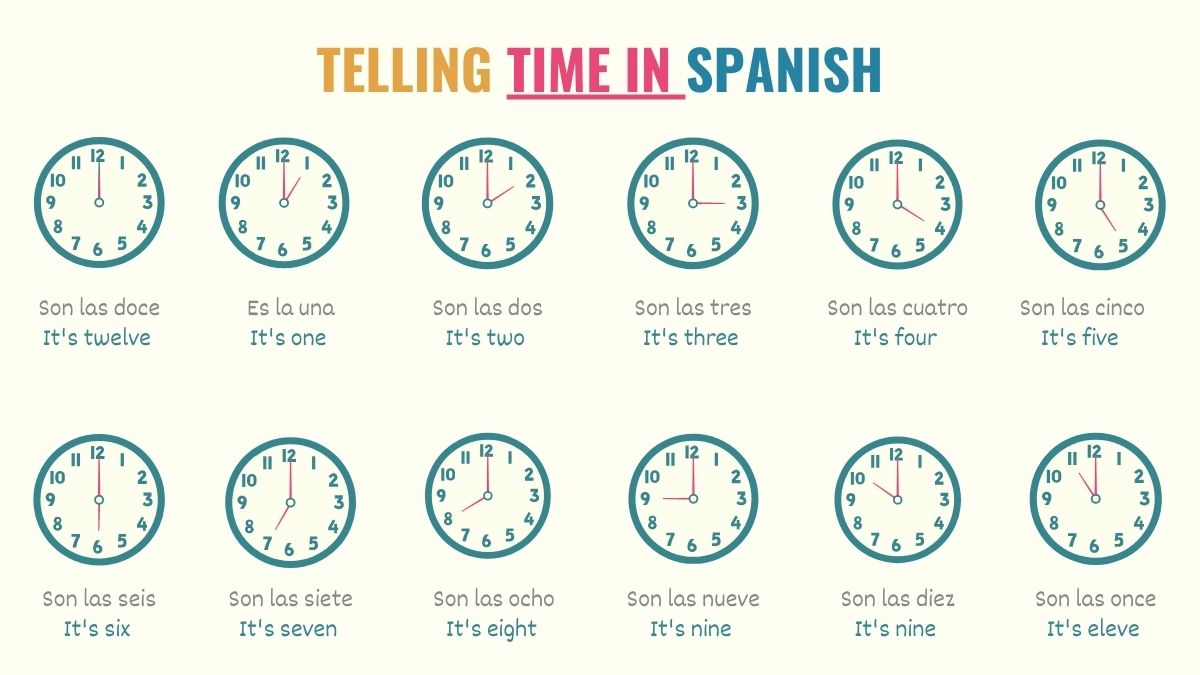
Take Note: You must always use definite articles when telling time in Spanish. In this context, la and las are replacing the Spanish feminine words hora and horas, which we use in formal situations. Check the examples below.
Full-sentence
Son las ocho horas con cinco minutos.
It’s eight hours and five minutes.
Short version
Son las ocho cinco.
It’s eight-0-five.
How to add minutes when telling time
In Spanish, we use the words ‘y’ and ‘con’ to add minutes when telling time (con is more formal). These words are the equivalent of saying ‘past’ or ‘after’ when telling the time in English.
Son las dos y veinte.
It’s twenty after two.
Son las cuatro con treinta.
It’s half past two.
So, the formula to tell time in Spanish (minutes included) looks like this:
[‘Ser’ conjugated] + [definite article] + y/con + [minutes]
Son las dos con veinticinco.
It’s two twenty-five.
¡Ya son las cuatro y cuarenta!
It’s four forty already!
Conversational Tip: The letter ‘y’ is usually omitted in speaking Latin American and Mexican Spanish. You can see this in the following examples.
Correct
Son las dos y veinte.
It’s two-twenty.
Correct
Son las dos veinte.
It’s two-twenty.
Using ‘menos’ when telling time in Spanish
In Spanish, ‘menos’ allows you to express the minutes remaining until the next hour. However, it can only be used for the remaining 25 minutes. So, when used to tell time, this word is close in meaning to:
- To
- Before
- Until / ‘till
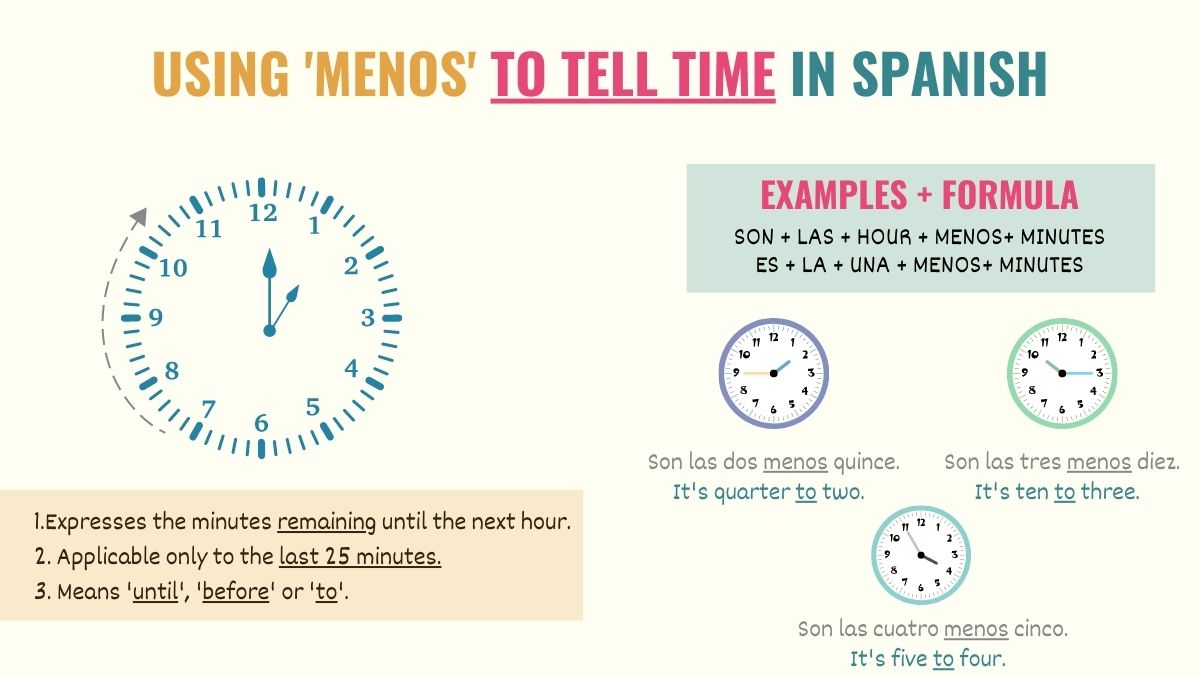
Here is the formula and some examples of how to use ‘menos’ in Spanish:
[‘Ser’ conjugated] + [definite article] + [hour] + menos + [remaining minutes]
Ya vístanse, son las ocho menos veinte.
Get dressed! It’s twenty minutes before eight.
Son las cinco menos diez, señora.
It’s five minutes to ten, ma’am.
Es la una menos quince.
It’s fifteen minutes till one.
Although menos is very common in this situation, you can also use the words ‘a’, ‘para’ and ‘faltan’ to convey the same meaning (the remaining minutes till the next hour).
[Ser conjugated] + [remaining minutes] + a/para + [definite article] + [hour]
Sí, señorita, son diez para las nueve.
Yes, miss, it’s 10 minutes before nine.
Son cinco a las siete, cerramos a las siete en punto.
It’s 5 minutes before seven; we close at seven on the dot.
Faltan + [remaining minutes] + a + [definite article] + [hour]
Faltan veinte a la una, ¿ya estás lista?
It’s twenty minutes to one, are you ready?
Mandy, ¡despierta! ¡Faltan cinco a las ocho!
Mandy, wake up! It’s five minutes till eight!
Depending on the Spanish-speaking country, some of these structures may be more common than others. For example, in Mexican Spanish prevails a, para and faltan.
Half & Quarter Hours
Media (half) and cuarto (quarter) replace the numbers treinta and quince, respectively. If you use these words to talk about the minutes past or after an hour, you necessarily must include the conjunction ‘y’ in your sentence.
[‘Ser’ conjugated] + (y) + [media/quince]
Son las doce y media.
It’s half past twelve.
Es la una y cuarto.
It’s a quarter past one.
Cuarto can also be used with ‘menos’ and ‘para’ to express the remaining minutes to the next hour. Check how we can use this word to say 12:45 and 9:45 in Spanish:
[‘Ser’ conjugated] + [definite article] + [hour] + menos + cuarto
Es la una menos cuarto.
It’s quarter to one.
Son las diez menos cuarto.
It’s quarter to ten.
Or:
Es + cuarto + para + [minutes]
Es cuarto para la una.
It’s a quarter to one.
Es cuarto para las diez.
It’s a quarter to ten.
Parts of the day in Spanish
When telling time in Spanish, it’s also very common to specify the part of the day you’re referring to. To do so, we use:
- Mañana – Morning
- Tarde – Afternoon/Evening
- Noche – Evening/Night
[‘Ser’ conjugated] + la/las + de + la + [time of the day]
Aquí apenas son las siete de la mañana.
It’s seven in the morning here.
Son las diez de la noche.
It’s ten at night.
Su cita es a las tres de la tarde.
Her appointment is at three in the afternoon.
Describing Time of an Event or Activity
In Spanish, there’s a distinction between telling time and saying the time when an activity will take place. To express the time when something is going to happen, we add the preposition ‘a’ between the verb ‘ser’ and the definite article. This is equivalent to saying that the event or activity is “at” a given time.
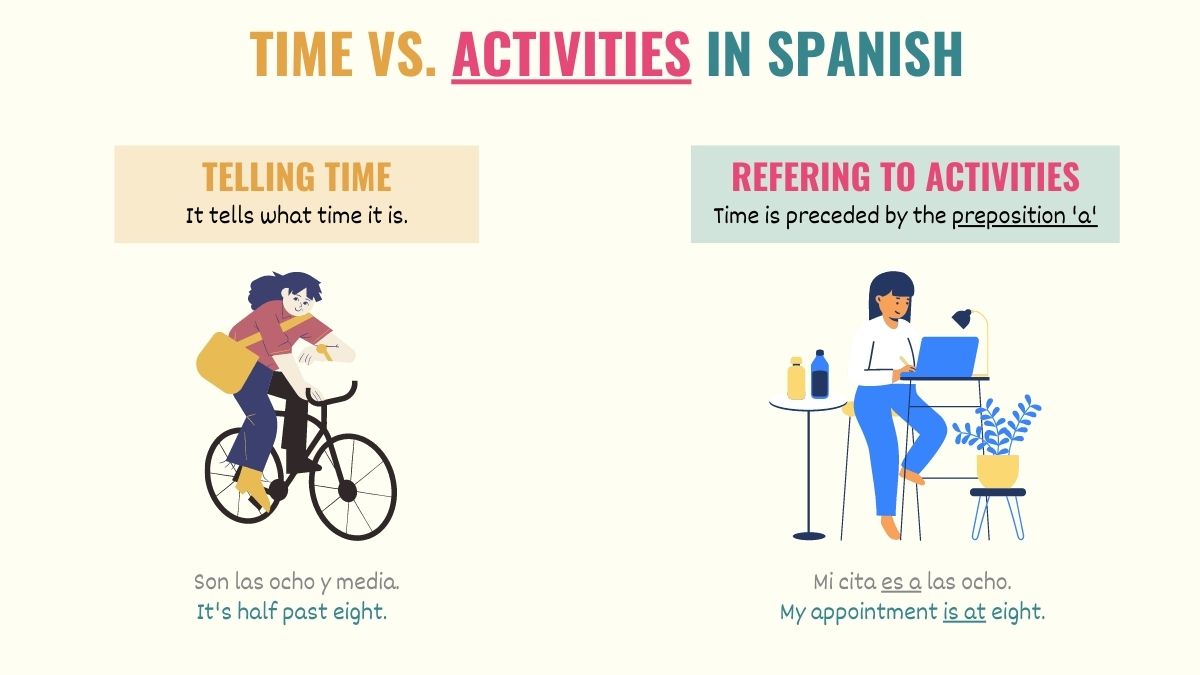
Telling the Time in the Past & Future
For many people telling time in different tenses is difficult. However, all you must do is conjugate ‘ser’ to the tense you need. To give you an example, in the following sections, you’ll learn how to tell time in the past and future tenses.
Time in the Past
In Spanish, you must use the imperfect tense to tell time in the past. So, instead of using es or son, you would use ‘era’ or ‘eran’. Aside from this change, you’ll keep using the elements that you’ve learned so far:
[‘Ser’ in the imperfect tense] + [definite article] + [time]
Era la una cuando Sam se durmió.
It was one when Sam fell asleep.
Creo que eran las seis menos veinte cuando Teddy llegó.
I think it was fifteen minutes to six when Teddy arrived.
Time in the Future
To tell time in the future tense in Spanish, just change the verb ‘ser’ to ‘será’ or ‘serán’.
[‘Ser’ in the future tense] + [definite article] + [time]
En unos minutos serán las dos de la tarde.
In a few minutes, it will be two pm.
Cinco minutos más y serán las doce de la mañana.
Five more minutes and it will be twelve in the morning.
24-Hour Time Format
You can also use the 24-hour clock if you need to. Notice that not all of this formula’s elements apply when the time is 1:00 am.
Son + las + [24 hour number] + horas + con + [minutes]
Es la una con treinta minutos.
It’s 0-one thirty.
Son las veinte horas con fifteen minutos.
It’s twenty quince.
Son las quince horas con cuarenta y cinco minutos.
It’s fifteen forty-five.
How to Ask the Time in Spanish
Below are some common questions you can use to ask people for the time in Spanish.
- ¿Qué hora es? – What time is it?
- ¿Me puede regalar su hora? – Could you tell me what time you have?
- ¿Qué hora tiene? – What time do you have?
- ¿Tendrá la hora? – Do you have the time?
Fanny, ¿qué hora es?
Fanny, what time is it?
Señor, ¿me puede regalar su hora?
Sir, could you tell me what time it is?
Disculpe, señora, ¿tendrá la hora?
Excuse, ma’am, do you have the time?
Essential Vocabulary to Tell Time in Spanish
Below you’ll find some common words that you can use when telling time in Spanish.
| Spanish | English |
|---|---|
| Cuarto | Quarter |
| En punto | On the dot / O’clock / sharp |
| De la mañana | In the morning |
| De la tarde | In the afternoon / In the evening |
| De la noche | In the evening / In the night |
| Faltar | Before / To / Until / ‘till |
| Menos | Before / To / Until / ‘till |
| Media | Half |
| Mediodía | Midday |
| Medianoche | Midnight |
Son las dos y cuarto.
It’s two fifteen.
Señorita, son las ocho en punto.
Miss, it’s eight on the dot.
¿Qué haces despierto? ¡Es medianoche!
Why are you awake? It’s midnight!
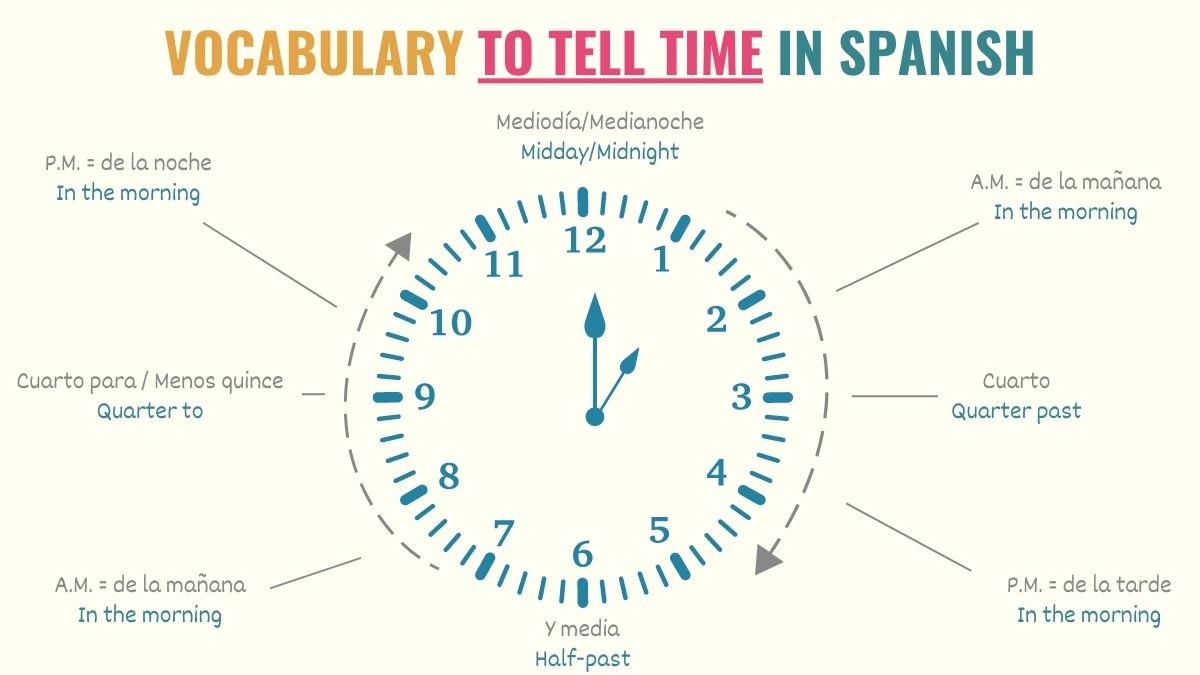
Key Points: Rules for Telling Time in Spanish
Telling time in Spanish is a necessary communication skill that you must have. Here are some key rules that you need to keep in mind in this situation:
- To tell time in Spanish, we need to use the third singular and plural form of the verb ‘ser’, feminine definite articles, and numbers.
- ‘Es la’ is only used when referring to 1:00 am or 1:00 pm. ‘Son las’ is the structure we use to refer to all the other hours.
- The conjunction ‘y’ and the preposition ‘con’ are used to add minutes in Spanish. You can omit these words in casual situations and conversational Spanish.
- The articles ‘la’ and ‘las’ are replacing the word ‘horas’.
- To tell time in the past tense, you must conjugate ‘ser’ to the imperfect tense.
- ‘Menos’ expresses the remaining minutes to the next hour. It means ‘to’, ‘before’ or ‘until’.
- ‘Menos’ can only be used with ‘veinticinco’, ‘veinte’, ‘quince’, ‘diez’ or ‘cinco’.

